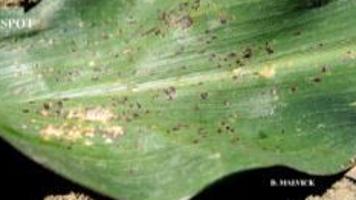
Tar spot of corn was found last fall for the first time in Minnesota. Several counties had occurrences of tar spot this year; Steele, Dodge, Goodhue, Le Sueur, Olmsted, Fillmore, Houston, Winona, Wabasha, Mower and Freeborn counties all had instances. The only documented occurrences confirmed in 2019 were in Fillmore, Freeborn, Faribault, and Winona counties.
Corn tar spot is caused by the fungus Phyllachora maydis. The tar spot fungus infects leaves –and sometimes husks – and produces raised, small (0.1 inch – 0.2 inch) raised black structures on the leaf surface. The black structures are firm and appear smooth on the surface. Corn tar spot can look somewhat similar to common rust on corn, but the spots do not rub off or break open like rust pustules. Tar spot can also produce fisheye symptoms that appear as black spot surrounded by tan lesions with dark borders. Tar spot has been observed most often during mid to late grain fill (growth stages R3-R6) and usually shows up on leaves below or near the ear leaf.
Though we’ve seen mostly mild cases in Minnesota, corn tar spot can become severe in the right conditions. Severe tar spot outbreaks can reduce yield by more than 30 bushels per acre. Yield losses are mostly a function of reduced ear weight, poor kernel fill, loose kernels, and vivipary (a condition in which the seed germinates while still on the cob).
Again, whether tar spot results in significant corn yield losses depends on weather, severity, and timing of disease development. The disease favors cool temperatures (60 — 76 degrees Fahrenheit), heavy dews, about six hours of leaf wetness, and relative humidity greater than 95%.
Temperatures above 80 F suppress disease development and inhibit the spread.
The risk of disease is highest where the disease has previously occurred. Phyllachora maydis can overwinter and thus can occur in nearby fields from one year to the next. So, even if the levels of disease are low and don’t impact yield, keep an eye on the area for future years.
Several management practices may help reduce tar spot development and severity. As of now, it seems that the best management practice is to use resistant corn hybrids and stay away from highly susceptible hybrids.
Also, be sure to manage residue the best you can. Tilling fields buries infected residue and encourages it to decompose, which may help reduce the amount of overwintering tar spot.
Rotating to other crops will allow residue to decompose and reduce the primary inoculum, though it is not known how many years it might take to sufficiently reduce the pathogen.
There are some fungicides that can be used to manage tar spot. However, there is little data about application timing that will provide an effective and economical response. It seems that fungicides may be most effective if applied early when few spots have appeared on the leaves.
November 13, 2020 at 09:45PM
https://ift.tt/38GI9Jm
Tar spot of corn found in the area this fall - Southernminn.com
https://ift.tt/3gguREe
Corn

No comments:
Post a Comment